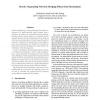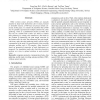362 search results - page 2 / 73 » Separation principles in wireless networking |
MOBISYS
2005
ACM
14 years 4 months ago
2005
ACM
Inverse multiplexing, or network striping, allows the construction of a high-bandwidth virtual channel from a collection of multiple low-bandwidth network channels. Striping syste...
ICASSP
2011
IEEE
12 years 8 months ago
2011
IEEE
A scalable blind source separation paradigm aimed at sensor networks is described. The approach facilitates an unlimited number of sensors and sources and does not require a fusio...
ICCCN
2007
IEEE
13 years 8 months ago
2007
IEEE
In 2003, interests in the Institute of Electronics and Electrical Engineering (IEEE) 802.11 Working Group (WG) led to the formation of Task Group (TG) "s". 802.11s develo...
HUC
2009
Springer
13 years 9 months ago
2009
Springer
Mobile sensors require periodic position measurements for navigation around the sensing region. Such information is often obtained using GPS or onboard sensors such as optical enco...
MDM
2009
Springer
13 years 11 months ago
2009
Springer
While wireless sensor networks (WSNs) are typically targeted at large-scale deployment, due to many practical or inevitable reasons, a WSN may not always remain connected. In this...


